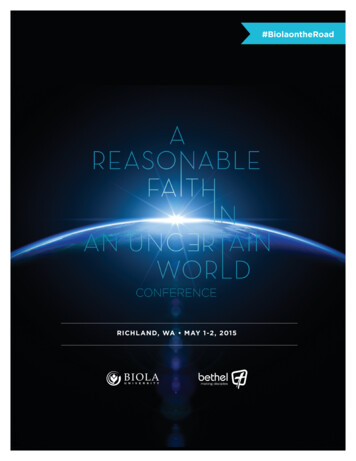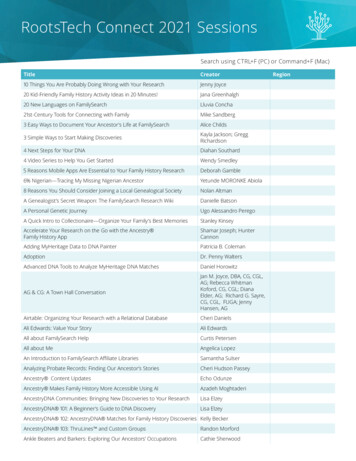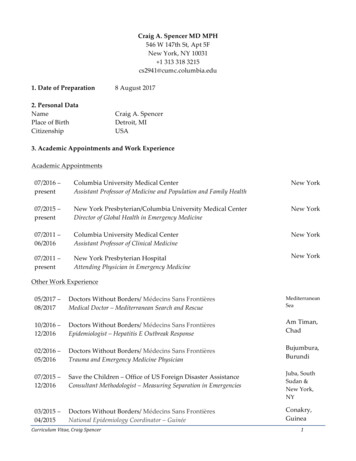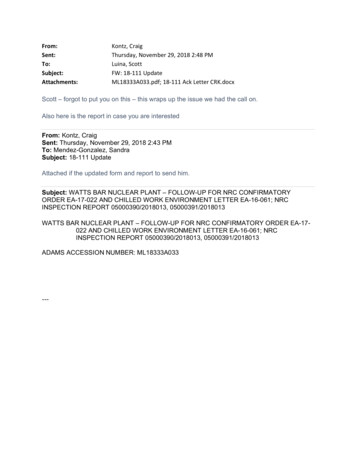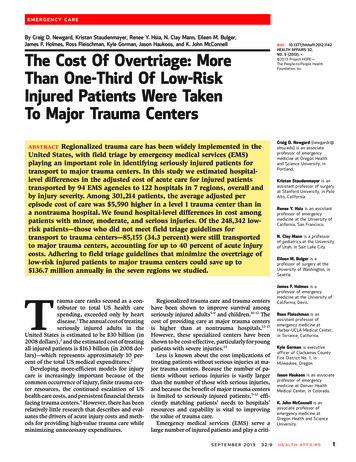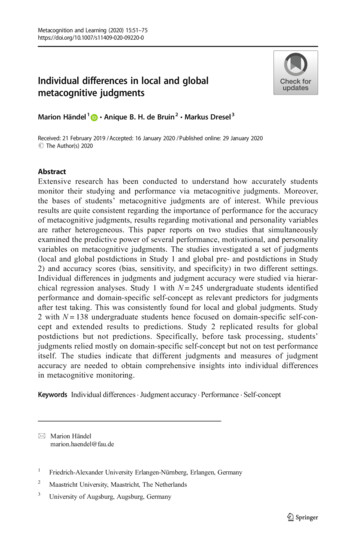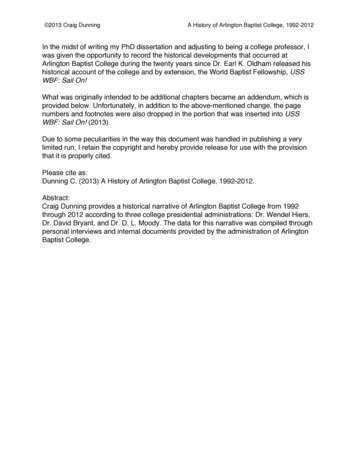
Transcription
2013 Craig DunningA History of Arlington Baptist College, 1992-2012In the midst of writing my PhD dissertation and adjusting to being a college professor, Iwas given the opportunity to record the historical developments that occurred atArlington Baptist College during the twenty years since Dr. Earl K. Oldham released hishistorical account of the college and by extension, the World Baptist Fellowship, USSWBF: Sail On!What was originally intended to be additional chapters became an addendum, which isprovided below. Unfortunately, in addition to the above-mentioned change, the pagenumbers and footnotes were also dropped in the portion that was inserted into USSWBF: Sail On! (2013).Due to some peculiarities in the way this document was handled in publishing a verylimited run, I retain the copyright and hereby provide release for use with the provisionthat it is properly cited.Please cite as:Dunning C. (2013) A History of Arlington Baptist College, 1992-2012.Abstract:Craig Dunning provides a historical narrative of Arlington Baptist College from 1992through 2012 according to three college presidential administrations: Dr. Wendel Hiers,Dr. David Bryant, and Dr. D. L. Moody. The data for this narrative was compiled throughpersonal interviews and internal documents provided by the administration of ArlingtonBaptist College.
2013 Craig DunningA History of Arlington Baptist College, 1992-20122
2013 Craig DunningA History of Arlington Baptist College, 1992-2012Forward to the 20th Anniversary Updated EditionIn 1992, Dr. Oldham published USS WBF Sail On as an historical account of the WorldBaptist Fellowship (WBF), the fundamental Baptist movement originally established byDr. J. Frank Norris in 1933 as the Premillennial Missionary Baptist Fellowship. His bookwas a monumental task that was made more challenging by his failing heart, whichprogressively worsened throughout the course of writing. During the final stages ofwriting USS WBF Sail On, the work was interrupted when Dr. Oldham became theworld’s oldest heart transplant recipient. That he came back to finish the project after hisheart transplant was testimony to the importance he placed on recording the history ofthe World Baptist Fellowship.Dr. Oldham preserved this movement’s history as best he could, depending on his andMrs. O’s memories of first hand experiences, which dated back to the earliest days.Those memories were meticulously cross-checked and supplemented by various writtenaccounts of WBF activities, including countless newspaper clippings, magazine articles,personal journals, and, in some cases, notations from the back of photographs.In the original edition of USS WBF Sail On, Dr. Oldham’s narrative ended with theappointment of Dr. Wendell Hiers as the interim president of Arlington Baptist College(ABC). And by God’s grace, Dr. Oldham’s record has now become dated, which is tosay, thank God, there is a need to update the book; the Fellowship and College are stillsailing! The Arlington Baptist College, World Baptist Fellowship, and WBF MissionAgency are still partnering with each other and with local churches to prepare men andwomen for Christian life and service.Dr. and Mrs. Oldham have done their part to preserve the history of the ministries of theWorld Baptist Fellowship and Arlington Baptist College. The baton has been passed tome, and it is now my turn to record the last twenty years’ history of the WBF. To thispoint, my personal connection to this movement has spanned thirty years: I was savedand baptized under Dr. Oldham’s ministry at Calvary Baptist Church, graduated fromABC twenty five years ago, and before becoming a faculty member at ABC in the fall of2011 was supported for many years by WBF churches to do evangelism in Israel.I am honored to have this opportunity to update USS WBF Sail On!, thus preserving forthose who come after me the history of our independent Baptist movement, which hasoccurred over the past twenty years. Honoring Mrs. O’s desire, as expressed in herforward to the 2001 reprint, I have chosen not to edit any portion of Dr. Oldham’saccount. Leaving it the way he wrote it, including the “[m]any obvious errors: grammar,punctuation and spelling . . .” that will be “preserved forever!,” is my effort to showappreciation and respect to both Dr. and Mrs. Oldham.In contrast to Dr. Oldham’s work, most of what I record is not my own memories.Because I have lived most of this period outside the United States, disconnected from3
2013 Craig DunningA History of Arlington Baptist College, 1992-2012the campus, I have been dependent upon information mostly gained by interviewingpeople who were involved in the events described. Many agreed to be interviewed, butdid not want to be quoted, which is fine. However, anonymous sources naturally createquestions of credibility or agenda. With that in mind, I crosschecked the things I was toldas much as I could. I have done my best to be fair in evaluating the opinions andmemories of those who were willing to be interviewed, drawing conclusions asgenerously as possible.A Long TransitionDr. Oldham concluded his portion of USS WBF Sail On with the announcement of Dr.Wendell Hiers being selected by the Board of Directors to serve as the interim presidentof Arlington Baptist College beginning January 1992. Interestingly, he noted that theappointment was “until May, 1992, at which time [the Board of Directors] will name anew president of the College who will be the new captain of the USS-WBF.”1 Ultimately,that timeline was short by one year, leaving Dr. Hiers to serve as interim president untilMay of 1993.The Board had been informed in May 1991 that Dr. Martin intended to resign. At thattime, they began to assemble a search committee that would make recommendationsregarding the next president of Arlington Baptist College. Clearly, the search took longerthan anticipated, which was indicative of the difficult situation that Dr. Hiers would faceas interim.The fellowship and school were still hemorrhaging from the 1984 split. While enrollmenthad been on a fairly steady decline since its peak in 1975-1976, it appeared to be amanageable decline. That changed in May 1984. The Spring 1984 enrollment of 314students dropped to 244 that Fall, and remained the largest student enrollment for theduration of Dr. Martin’s tenure. The Fall 1991 enrollment of 134 students was adecrease of almost 60% from Spring 1984, the semester prior to the split.Those were dark days on the campus. Student enrollment was at a 30-year low. To sayfinances were tight would be both an understatement and misleading. To be honest, thefinancial situation was impossible. Paired with a severe decrease in enrollment,offerings were dwindling at an alarming rate. Dr. Oldham accurately described a numberof things that had converged to create the perfect storm that had settled over ArlingtonBaptist College2: The fragmentation that now seems inherent among independentBaptists had done inestimable damage. And if that were not enough, the school wasalso suffering from a sluggish economy, the rising cost of education, fewer students andsmaller offerings from churches. All of these things continued to hinder Dr. Martin’sefforts to rebuild the College, though by all accounts, he gave a yeoman’s effort.12Oldham, Earl K. USS WBF Sail On. Self published, Grand Prairie, Texas. 1992, 350.Ibid., 348.4
2013 Craig DunningA History of Arlington Baptist College, 1992-2012During Dr. Martin’s tenure, three things occurred that appeared to give a glimmer offinancial hope: ABC received a large gift from the September 1982 sale of the ArlingtonVilla, which was set up as an endowment;3 in the late 1980’s the school sold 22 acres ofland to a developer;4 and in 1989 at the Jubilee celebration, ABC received 365,048.00,the largest cash offering ever.5Eventually, though, the property that had been sold was returned with tax debt in towand the Arlington Villa endowment was incrementally withdrawn and used for operatingexpenses, as was the Jubilee offering. Ultimately, the two large gifts and land sale wereinsufficient to turn the financial tide.Dr. Martin felt like he had done all he could do and tendered his resignation, effectiveJanuary 6, 1992. Dr. Oldham personally recruited Dr. Hiers to serve as interim, whichseemed appropriate in so many ways. By that time, Dr. Hiers had become the pastor ofCalvary Baptist Church, Grand Prairie, Texas. But that was not his only connection tothe World Baptist Fellowship. For twenty-six years he and his wife Daisy had served asWBF missionaries in Brazil, which was followed by six years as the director of the WorldBaptist Fellowship Missions Office. He definitely had the pedigree, but pedigree alonewouldn’t provide stability to what one board member sadly labeled the “Titanic.”No matter how much experience one has, it seems without actually sitting in thecaptain’s seat, no one can imagine the complexity of steering this ship. In addition to allthe problems already mentioned, Dr. Hiers almost immediately came to feel the tensionbetween his two roles, that of pastor of Calvary Baptist Church and that of interimpresident of Arlington Baptist College. When a business is in dire financial straights, it iscommon to reduce staff through retirement and or layoff. In his case, though, Dr. Hiershad to face the reality that a number of members of his church made up a sizableportion of the faculty and staff at the College. The problems of the school were nolonger theoretical; they very quickly became agonizingly personal. Meanwhile, the boardcontinued to search for the right person to take the helm long-term.Seemingly against all odds, Dr. Hiers did bring stability if that is measured byenrollment. For the one semester he agreed to serve, Spring 1992, student enrollmentremained the same as Fall 1991, 134 students. His second semester as interimpresident saw an increase of fifteen students, which was then increased significantly atthe May Fellowship, when sixty people signed up to take Dr. Sullivan’s visual aidscourse during that week.In many ways Dr. Hiers must have felt like the little boy plugging holes in the dam. Witheach leak at least temporarily stopped, another would appear. And he was quickly3Ibid., 342.Ibid., 348-9.5Ibid., 349.45
2013 Craig DunningA History of Arlington Baptist College, 1992-2012running out of fingers to put in the holes. Dr. Hiers was literally giving his life for thecause, and the demands of pastoring Calvary Baptist Church and managing the Collegein its dire condition were evident to those who were watching. The physical toll wasillustrated well when late one evening while driving home from another hard day at theoffices, Dr. Hiers fell asleep at a traffic light and was awakened only when a manknocked on his window while checking on him. His investment, yes sacrifice, should notgo unnoticed or unappreciated.Even though the bleeding had temporarily stopped in terms of enrollment, donationsremained weak and facility needs continued to increase. Morale was very low. Trust hadbeen lost. Loyalties were questioned. Jobs were at stake. Rumors were spread. Thingswere so unsettled that the rumor that a Catholic priest was teaching at ABC was beingpassed around the Fellowship. That such a rumor could get any traction indicated thatthe general perception of the school was clearly at an all time low. One faculty memberreported that, on at least two occasions, he happened upon former students who werevisiting campus to verify reports that the school had closed. The situation at that timewas eerily similar to Dr. Oldham’s description of the time a false accusation against himand Dr. George Norris was circulated in the late 50’s: “ . . . even though their case wasunjust and what they said was not true, there were those who fragmented and left theranks of the World Baptist Fellowship. We lost some contributors and some potentialcontributors.”6 However, Dr. Hiers’ situation in the 1990’s was more desperate than thesituation of the 1950’s.Offerings remained low, and to keep the school afloat, the decision was made, onceagain, to sell the property north of the dormitories. Dr. Oldham and others hadenvisioned retired missionary housing being built there, but that idea had to besacrificed for the survival of the school, though survival was certainly not guaranteed.This was the only remaining asset that could be liquidated without sacrificing parts or allof the currently in-use campus. Selling the entire campus and moving into a storefronthad previously been suggested during Dr. Martin’s tenure, but the idea came to a haltwhen opposition was expressed, particularly by Woody Cash during a pastor’s advisorymeeting at the May Fellowship. At that time, Mr. Cash felt that he and others had not yetsacrificed enough to save the school, and that selling the campus would be an injusticeto the labor and sacrifice of previous generations.Dr. Hiers, though discouraged and physically exhausted at times, never lost hope. Hecontinued, well beyond his initial commitment of one semester, to try to maintainstability. However, the unfortunate reality was that the “temporary” label that is naturallyplaced on interim leadership made it impossible to cast vision, build confidence, or doany type of capital campaign. Generally, people are hesitant to invest deeply in atemporary situation.6Ibid., 259.6
2013 Craig DunningA History of Arlington Baptist College, 1992-2012Dr. Hiers’ efforts to simply hold things together until a permanent president could bedesignated by the board were being severely challenged by deterioration of at leastthree things: the support base, student confidence, and the physical plant. It appearedthat donors had all but walked away; the enrollment for his third and final semester haddeclined to a new low of 126 students, and the buildings were crumbling. Not only werethe buildings crumbling, the ground was eroding, too. If anything could appropriatelyillustrate the dire situation of the school, it was the discovery that the hillside waseroding from under the utility building. This was not only another potentiallybackbreaking financial issue, it well illustrated the erosion that had and continued totake place on the hill and within the World Baptist Fellowship.Early in the Spring 1993 semester, there was a new development. It took almost twoyears, but it appeared the board might have finally found the right man to lead ABC. Aspart of his consideration of whether to accept their offer, the candidate went to visit Dr.Hiers with one question in mind: “Is the school salvageable?” Dr. Hiers was candid, buthopeful: “We are over a half million in debt, but yes, it is salvageable.”7Through it all, Dr. Hiers believed there was still hope, and that hope was one of thefactors that convinced David Bryant to accept the call to become the next president ofArlington Baptist CollegeThe Tenure of David BryantDavid Bryant was a member of the board of directors and was actively involved infinding the sixth president8 of Arlington Baptist College. In the process of scouring theland for a viable candidate, he had not considered himself for the job. But that allchanged during a board meeting when a couple of his fellow board members turnedtoward him and asked, “What about you?”9Some thought the suggestion was a last ditch effort to find somebody, anybody willing(or foolish) enough to take on the task of righting this ship. After all, how many peoplewould want to captain the Titanic?10 There were some who thought Dr. Bryant’s lack offormal education beyond his three-year bachelor’s degree earned at Bible BaptistSeminary disqualified him for the position.11 However, others thought the idea of DavidBryant as the president of ABC was the right decision, and many were surprised that hehad not been considered sooner.Mr. Bryant’s supporters suggested that anything he might have lacked in advancedacademic degrees was mitigated by a number of things: the discipline of self-study that7Personal interview with Dr. Hiers, 12/19/11.This number includes Dr. Hiers’ interim presidency: Norris, Peak, Oldham, Martin and Hiers.9Personal interview with Vickie Bryant, 12/15/11.10Several people used the Titanic reference during interviews for this update.11Dr. Bryant earned a Masters of Theological Studies from Louisiana Baptist University in 2004.87
2013 Craig DunningA History of Arlington Baptist College, 1992-2012was demonstrated, for example, in his memorization of large portions of the Bible; histwenty-four years experience as a pastor12 coupled with sixteen years as a Christianschool administrator;13 and his World Baptist Fellowship pedigree. Additionally, somebelieved that as the salutatorian of the final graduating class of Bible Baptist Seminaryin 1972 that he demonstrated plenty of academic acumen, and, perhaps moreimportantly, he could maintain (or regain, as some thought) ABC’s connection with herheritage.Whatever the case, the idea of David Bryant becoming the next president of ArlingtonBaptist College had been raised and, therefore, had to be considered from both sides.Overall, the Board of Directors was in favor, but Pastor Bryant needed to consider theramifications of accepting the call to become President Bryant. He had been the pastorof Bible Baptist Church, Wichita Falls, Texas and administrator of the church’s Christianschool for sixteen years. He had to consider what relocation would mean to his family.He also had to consider the viability of the College. After much prayer and deliberation,the Bryants accepted the call to serve at ABC and moved to Arlington for the secondtime.First Move to Arlington, TexasDavid and Vickie Bryant had been married just under two years when they left Ohio andmoved to Arlington, Texas in July 1969. The Ohio natives had heard of J. Frank Norrisand the Bible Baptist Seminary at the Dayton Baptist Temple where their pastor, GeraldFleming, recommended the school to all the young people in the church. Mr. Bryant hadbeen saved in 1967 while serving in the United States Army in Newport News, Virginia.Having been called into the ministry shortly thereafter, the 23-year-old David Bryantintended to go to seminary to learn as much about the Bible and preaching as he could.He did well in the classroom, graduating as salutatorian in 1972. Mrs. Bryant gained hereducation by typing her husband’s class notes at night.Mr. Bryant’s sharp mind and hard work caused him to stand out as a strong student, buthe was not interested in only being an academic. He wanted to fulfill his call to ministryas soon as possible. One of the principles of the school since its inception was that aspart of their training, all students should be involved in some type of ministry in theirlocal church. Obviously, not every student was ready to be a pastor upon arrival at theschool, but surely they could do something of service in their local church. And eachstudent was required to get involved in some type of ministry at their local church. Anyhost of ministries would qualify. For example, among the many options were Sundayschool teacher, home visitation and soul winning, nursing home ministry, youth ministry,12Dr. Bryant served as associate pastor of Victory Baptist Church, Weatherford, Texas (1969-72); pastorof Tabernacle Baptist Church, Crane, Texas (1972-77); and pastor of Bible Baptist Church, Wichita Falls,Texas (1977-1993).13Dr. Bryant served as head administrator of Bible Baptist Christian School, Wichita Falls, Texas (19771993).8
2013 Craig DunningA History of Arlington Baptist College, 1992-2012or bus ministry. For David Bryant, it took only three months into his freshman year tobecome the associate pastor of the Victory Baptist Church in Weatherford, Texas.Similarities with Dr. OldhamDuring his days as a student, several things were burned into Dr. Bryant’s soul, many ofthem a reflection of what he saw modeled by Dr. Oldham. “From behind the plow tobehind the pulpit” was commonly heard around campus in those days, and Mr. Bryantnever got over the idea that common men could be soul winners, preaching the gospelto anyone who would listen. Dr. Oldham was known for strong preaching, and the youngDavid Bryant embraced this wholeheartedly and honed his own preaching skills after Dr.Oldham.He also saw in Dr. Oldham a man who would work long hours, doing whatever wasnecessary to get the job done. Dr. Bryant became the same type of committed laborerhimself, one who earned the respect of others by putting in the time necessary to getthe job done. As a demonstration of respect, one staff member referred to PresidentBryant as “Seven to Seven” because he was regularly “in his office from seven in themorning until seven at night.” Even after a long road trip, when others might grantthemselves a reprieve, Dr. Bryant got up early and made his way into the office.Based on the many similarities between the two, several people said that Dr. Bryantwas “cut from the same cloth” as Dr. Oldham. One person who knew them both verywell said they “shared the same leadership style,” and went on to explain that both were“predictable because they were men of principle.” They were both firm and decisive intheir leadership, especially under adverse circumstances, and both seemed to becontinually surrounded by adverse circumstances.This same person added that both Dr. Oldham and Dr. Bryant “encouraged their staff byrecognizing the small details.” They might notice someone in the office had beenworking extra hours, and simply walk in and say, “Go ahead and take off early today;you’ve earned it.” They cared much for their staff, and on many occasions privately gavean encouraging gift or word just when it was needed most. Many faculty members whoserved under Dr. Bryant have only good things to say about him, especially words ofappreciation for his character and care for them.Both Dr. Oldham and Dr. Bryant were described as micro-managers. More than oneformer Ensemble member said that Dr. Bryant was never as happy as he was when hewas driving the bus or sitting at the sound board adjusting knobs. In both places, “hewas in complete control.”As president of ABC, Dr. Bryant saw himself first and foremost as a preacher andteacher of the Bible. His vision for the school was to maintain the work of men like Dr.Oldham and Dr. Martin whom he had studied under as a student as well as worked with9
2013 Craig DunningA History of Arlington Baptist College, 1992-2012while a board member. He intended to do this by standing strong for Baptist doctrineand the primacy of the local church, and preserving the school’s priority of trainingpreachers and missionaries. The school was in such dire shape survival appeared nextto impossible. But there were those who where still hopeful, thinking, “we’ve been herebefore, and we survived then.”According to Dr. Oldham’s account, survival of the school had been in question manytimes, perhaps more times than not, throughout its 50-plus years of existence. Thesituation that Dr. Oldham inherited when he became president of Bible Baptist Seminaryin 1953 was very similar to the situation that the newly installed President Bryant faced.Dr. Oldham described the financial problems of the Seminary in his day as being longstanding and growing to “almost astronomical proportions” as a result of the 1950 split.14Yet, time and time again, they made enough recovery to keep the doors open. Changethe names and dates and that accurately describes 1993.However, the similarities notwithstanding, the newly-installed President Oldham had atleast two advantages over the newly-installed President Bryant. First, though the WorldBaptist Fellowship was still wounded from the first split, independent Baptists, as amovement in the 1950‘s, were not nearly as fractured as they had become by the1990’s, which meant there were still only a few Independent Fundamental Baptistcollege options at that time. By the 1990’s, as a result of various schisms and splitswithin the movement, a number of independent Baptist schools and Bible institutes hadbeen opened, which provided more options for training within an independent Baptistframework.The result of the schisms and subsequent establishment of new schools was fewerstudents at the more historic institutions. A comparison of the first semester enrollmentsof President Oldham and President Bryant illustrates this point well: In the Fall 1953semester Dr. Oldham had 287 students,15 almost double the 14816 that Dr. Bryantbegan with in Fall 1993.Dr. Bryant Faces the ChallengeAt a school like ABC, one without a large endowment or donor base, enrollment is thekey to viability. That meant that Dr. Bryant had to roll up his sleeves and get to workrecruiting students. During his first semester as president there was an immediateincrease of 22 students over the previous semester, which was exciting news. Likely,that initial boost was mostly attributable to the appointment of a permanent president,but the steady increase over the next several years should be attributed to hisleadership and hard work, tackling several issues simultaneously: student recruitment,14Oldham and Oldham. 216.Ibid., 233.16Caner, E. Historical Enrollment Survey. 2012. This and all subsequent enrollment figures are derivedfrom this document.1510
2013 Craig DunningA History of Arlington Baptist College, 1992-2012increasing the donor base, improving the education department, and the renovation ofthe physical plant.He immediately began a plan to restore the crumbling infrastructure, and as financesallowed, every building had been renovated by the time he resigned. Local churchworkdays and adopt-a-dorm-room efforts all played a part in improving the verydeteriorated dorms. The most practical and successful plan to refurbish the buildingswas the Impact Partner Program, which was initiated in 2005. This program wasimplemented and promoted by Mike Evans, who was hired primarily to introduce it toWorld Baptist Fellowship churches. At its peak, about 1,300 Impact Partners committedto give 2.00 per week to Arlington Baptist College for the specific purpose of improvinginfrastructure. Impact Partners were instrumental in helping Dr. Bryant bring the schoolout of debt because their gifts toward building renovation released other monies to beused toward debt retirement and other operation costs.Steadily increasing student enrollment also helped bring the financial crisis undercontrol. In his first academic year, 1993-1994, Dr. Bryant had a two-semester combinedenrollment of three hundred three. While this was still a relatively small number, itrepresented a ten percent increase over the previous year’s combined enrollment of twohundred seventy five. Dr. Bryant saw another ten percent enrollment increase during hissecond year, 1994-1995.Each of Dr. Bryant’s first seven years had enrollments that steadily increased betweentwo to eighteen percent. This resulted in a “burn the note” debt retirement ceremony,which may have been the highlight of the 1999 May Fellowship meeting. During Dr.Bryant’s tenure, the highest combined enrollment of four hundred seventy one studentsoccurred in 2001-2002.The EnsembleThe primary tool for recruiting churches and students under Dr. Bryant was the travelingmusic group, The Ensemble. Initially, President Bryant asked Homer Hess, pastor ofSouth Center Baptist Church, to organize and work with the Ensemble. Unfortunately,due to his sudden death, Pastor Hess was able to fill this role for only one school year.Jimbo Cash, the music director at Calvary Baptist, Grand Prairie, was hired to replacePastor Hess to work with the Ensemble on campus only, and he continued in thatcapacity until Dr. Bryant’s resignation in 2009.In the beginning, the group’s music offerings were southern gospel oriented with onlypiano accompaniment. However, as time passed, they began to perform limitedselections of more contemporary music from artists like Chris Tomlin and Phillips, Craigand Dean. By this time, the pianist had been replaced by recorded music, which wasuncomfortable for some pastors. The selection of music was always challengingbecause of the variety of tastes and convictions of the churches the Ensemble visited.11
2013 Craig DunningA History of Arlington Baptist College, 1992-2012For some churches drums were out of the question, while others, like Calvary BaptistChurch, Grand Prairie had used drums since about 1981. “Dr. Oldham was way aheadof most of the fellowship, using drums, guitars, and even doing cantatas,” Mr. Cashexplained. And based on his experience growing up under Dr. Oldham’s ministry, Mr.Cash said that he continually encouraged Dr. Bryant to expand the Ensemble’srepertoire to also include some more contemporary music. Referring to morecontemporary music, Mr. Cash remembered saying many times, “You can do this, Dr.Bryant,” and he appreciated Dr. Bryant’s willingness to listen, even if it took a while toconsent.The Ensemble’s travel schedule was quite demanding, regularly being on the road morethan thirty weekends each school year with an additional five weeks during the summer.While most of the former members who responded to requests for interviews had verypositive memories of their time in the group, they also frequently commented on howdemanding it was to travel each weekend while trying to keep up with their studies. Afew mentioned the irritation of the relationship drama and personality conflicts thatnaturally occur in college traveling groups, but all agreed that the most difficult aspectwas returning to campus after Sunday night performances and being expected to be inclass on Monday mornings, no matter how late they arrived.Overall, it seems that most of the Ensemble members have fond memories of travelingtogether. Some found life partners. Others found lifelong friends. But almost all told offinding a new appreciation for Dr. Bryant wh
appointment of Dr. Wendell Hiers as the interim president of Arlington Baptist College (ABC). And by God's grace, Dr. Oldham's record has now become dated, which is to say, thank God, there is a need to update the book; the Fellowship and College are still sailing! The Arlington Baptist College, World Baptist Fellowship, and WBF Mission
